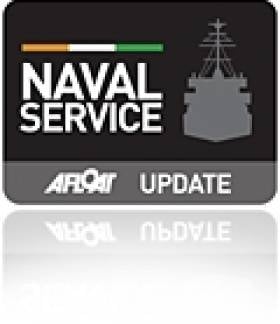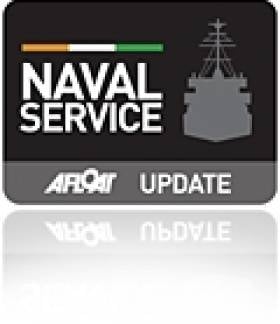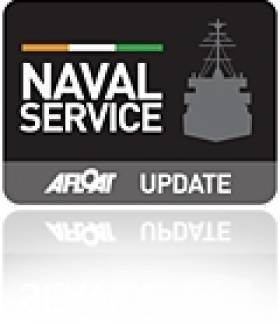Displaying items by tag: L.E. Eithne
US Navy Dock Landing Ship Departs Dublin Bay’s Shipping Scene
#US NAVYSHIP DEPARTS – At lunchtime the United States Navy dock-landing ship USS Fort McHenry (LSD-43) departed Dublin Port, after her visit for American Football Week, writes Jehan Ashmore.
Waiting out in Dublin Bay was the Irish Naval Service 'flagship' L.E. Eithne (P31) which had gone to anchorage having also stayed in the capital concurrently to the naval visitor. As USS Fort McHenry headed out on an easterly direction L.E. Eithne got underway too and proceeded southbound.
Other shipping activity in the bay included Seatruck Ferries newbuild freight-only ferry, Seatruck Progress, the ro-ro vessel serves on the Dublin-Liverpool route. Also at anchorage was Broström Tankers coastal tanker Bro Genius (2003/4,107grt).
Further out in the bay at the North Burford Buoy was Dublin Port Company's multi-cat Rosbeg, the workboat tender craft performs a wide variety of duties inside and outside the port, from cleaning the river to quay maintenance, bed levelling and buoy-handling.
Closer to shore, nearer to Dun Laoghaire Harbour was the cutter Cosantoir Bradan (meaning Salmon Defender) which as previously reported is on charter from the Central Fisheries Board to the Geological Survey of Ireland (GSI). They are using the cutter in conjunction with their RV Keary for survey work, including bottom surveying.
RV Keary attended the Dublin Tall Ships Races Festival, where she was moored in Grand Canal Dock which was also occupied by a fleet of narrowboats moored at the marina of the Waterways Visitor Centre.
Naval Service Seeks Recruits
#NAVAL SERVICE – The Naval Service are currently accepting applications for General Service Recruits.
There are additional positions available within the Defence Forces for General Service and Specialist positions.
For information on all these appointments, noting the relevant links for further details can be found by visiting: www.military.ie
The navy has a fleet of eight vessels led by the flagship LE Eithne (P31), to see the list click HERE.
Homage Paid to Irish Founder of Argentinian Navy
#ADMIRAL BROWN- As Wexford is to host The John Barry Maritime Festival this summer, the father of the US Navy and commodore is held in the same league of Admiral William Brown, who founded the Argentinian Navy, who was remembered in a ceremony over the weekend in Buenos Aires, writes Jehan Ashmore.
The commemoration was to mark the 155th anniversary of William Brown's passing which took place at the Recoleta Cemetery, which was headed by Vice Admiral Carlos Alberto Paz, Chief of Staff of the Argentine Navy.
Among those attending were the Irish Ambassador, Mr. James McIntyre, the Chairman of the National Brownian Institute, Prof. Emilia Menotti, the President of the Naval Club, Vice Admiral Eduardo R. Llambi (Ret.) and City Council Officials.
The Navy General Directorate for Education marching band was also present, as well as Officer Cadets from the Admiral Brown Naval Lyceum (Reserve Officers' Academy). The Irish flag was carried alongside the host country by officers of the HQ Security Marine Bn.
For more about the event which included Santiago L. Aversa who represented the Irish branch of the Maritime Institute of Ireland (click HERE) and where its maritime museum in Dun Laoghaire is due to reopen early next month as previously reported on Afloat.ie
In 2006 the Naval Service 'flagship' L.É. Eithne (whose adopted homeport is Dun Laoghaire) under the command of Commodore Mark Mellett, made a historic first for the Naval Service when visiting Argentina and other South American ports.
In the same year two identical statues of the admiral were unveiled, one in Dublin's Docklands at Admiral Brown Way and Westport, Co. Mayo where the admiral hailed from.
Admiral Brown won victories against the Spanish and Brazilian fleets and as such he is regarded as a national hero, where in excess of 1,000 streets, 400 statues and venues such as stadiums (including football teams) schools, several towns, and a major city bears his name.
- naval service
- Argentinian Navy
- L.E. Eithne
- Commodore John Barry
- Admiral William Brown
- Commodore Mark Mellett
- M.I.I.
- Maritime Institute of Ireland
- Mariners Church Dun Laoghaire
- Maritime Museum Dun Laoghaire
- Dublin Docklands
- The John Barry Maritime Festival
- Admiral Brown Way
- Irish Ambassador McIntyre
- Westport Co Mayo
- Wexford Town
Appointment of New Head of the Naval Service
To read more about this new appointment as reported by RTE click HERE
































































